Experimental study on total dissolved gas supersaturation in water
Lu QU, Ran LI*, Jia LI, Ke-feng LI, Lin WANG
1. Zhejiang Institute of Hydraulics and Estuary, Hangzhou 310020, P. R. China
2. State Key Laboratory of Hydraulics and Mountain River Engineering, Sichuan University, Chengdu 610065, P. R. China
Experimental study on total dissolved gas supersaturation in water
Lu QU1,2, Ran LI*2, Jia LI2, Ke-feng LI2, Lin WANG2
1. Zhejiang Institute of Hydraulics and Estuary, Hangzhou 310020, P. R. China
2. State Key Laboratory of Hydraulics and Mountain River Engineering, Sichuan University, Chengdu 610065, P. R. China
More and more high dams have been constructed and operated in China. The total dissolved gas (TDG) supersaturation caused by dam discharge leads to gas bubble disease or even death of fish. Through a series of experiments, the conditions and requirements of supersaturated TDG generation were examined in this study. The results show that pressure (water depth), aeration, and bubble dissolution time are required for supersaturated TDG generation, and the air-water contact area and turbulence intensity are the main factors that affect the generation rate of supersaturated TDG. The TDG supersaturation levels can be reduced by discharging water to shallow shoals downstream of the dam or using negative pressure pipelines. Furthermore, the TDG supersaturation levels in stilling basins have no direct relationship with those in reservoirs. These results are of great importance for further research on the prediction of supersaturated TDG generation caused by dam discharge and aquatic protection.
total dissolved gas supersaturation; dissolved gas in water; experimental study; dam discharge
1 Introduction
The supersaturation of total dissolved gas (TDG) is caused by dam discharge, and it may cause gas bubble disease in fish and ultimately endanger their existence (Tan et al. 2006). Overseas research on TDG supersaturation has been conducted since many years ago. In the 1960s, studies focused mainly on the effects of TDG supersaturation resulting from spill discharge of hydraulic engineering structures in the Columbia River, which harmed fish (USACE 2005; Orlins and Gulliver 2000). Weitkamp and Katz (1980) observed the death of fish caused by TDG supersaturation in the Saint John River of Canada. Huang (2002), Urban et al. (2008), and Politano et al. (2007, 2009) established different two-phase flow models of TDG supersaturation. The calculated TDG supersaturation levels were in agreement with the observed data. Since more and more dams are constructed and operated in China, the problem of TDG supersaturation has become increasingly prominent. In recent years, the TDGsupersaturation problem and its negative effects on fish have captured the attention of researchers in China. The research includes the supersaturated TDG generation (Li et al. 2009; Chen et al. 2009a) and release processes (Feng et al. 2010), the impacts of supersaturated TDG on fish (Tan 2006), and TDG abatement measures. Studies on supersaturated TDG generation are of great importance because they can allow for the prediction of TDG supersaturation levels downstream of high dams, and can help to explore improved methods for mitigating the effects of supersaturated TDG.
Currently, studies of the conditions for and the theory of supersaturated TDG generation downstream of high dams are not systematic. The preliminary study of Jiang et al. (2008a) indicated that the aeration and bubble size were directly related to the TDG supersaturation in a stilling basin. Furthermore, they established a relation between the TDG supersaturation level and the water depth (pressure) of the stilling basin. In addition, field observations of TDG downstream of high dams were conducted (Jiang et al. 2008b; Qu et al. 2011). Chen et al. (2009b) studied the supersaturated DO generation caused by the Three Gorges Dam discharge, and discussed the effects of supersaturated reoxygenation. Qin and Li (2008) performed preliminary numerical simulations of supersaturated DO and reoxygenation when the dam discharges water. Based on comprehensive analysis of previous studies, it is clear that a better and more universal forecasting model for supersaturated TDG generation is needed. In this study, an experimental study was conducted to investigate the generation conditions and influencing factors of the supersaturated TDG.
2 Definition of TDG saturation level
Gas solubility is the volume of gas that can dissolve in a solvent (yielding a saturated solution) at a specific pressure and a specific temperature. If the volume of the dissolved gas is greater than the gas solubility, it is called TDG supersaturation. The TDG saturation level,G, is defined as follows:

whereCis the concentration of TDG (mL/L), andCsis the solubility of TDG at the local atmospheric pressure and temperature (mL/L).
TDG includes nitrogen, oxygen, carbon dioxide, and rare gases. Due to the difficulty of measuring certain dissolved gases, such as nitrogen and argon (Watson et al. 1998), the TDG saturation level is obtained by calculating the total dissolved gas pressure based on the principle that the concentration of dissolved gas is proportional to the gas partial pressure. The TDG saturation level can be written as follows:

wherePBis the local atmospheric pressure (mmHg), and ΔPis the difference between the total dissolved gas pressure and the local atmospheric pressure (mmHg).
3 Study of gas bubble dissolution and release
In order to explore the generation conditions of the supersaturated TDG and its influencing factors, a series of self-designed experimental facilities were used to study the process of gas bubble dissolution and release.
3.1 Gas bubble dissolution experiment
The experimental device of gas bubble dissolution is shown in Fig. 1. The main device was a plexiglass cylinder with a height of 2.0 m and a diameter of 0.4 m. The experimental water depth was 1.38 m. Compressed air generated by an air compressor entered the water through a 1 mm-diameter pinhole in the main device. Gas flow was regulated by a valve in the intake manifold. The TDG pressure in water was measured using a YSI 5200 TGP probe made by the Yellow Springs Instrument (YSI) Company. The TGP probe was placed at a depth of 1.2 m underwater. The TDG saturation level was obtained by dividing the TDG pressure by the local atmospheric pressure. Calibration showed that the instruments’ measurement errors were about ± 0.1%. We used pretreated TDG unsaturated water. By raising the water temperature to cause part of the dissolved gases to release and then rapidly cooling the water to room temperature, we brought the TDG saturation level to less than 100%.
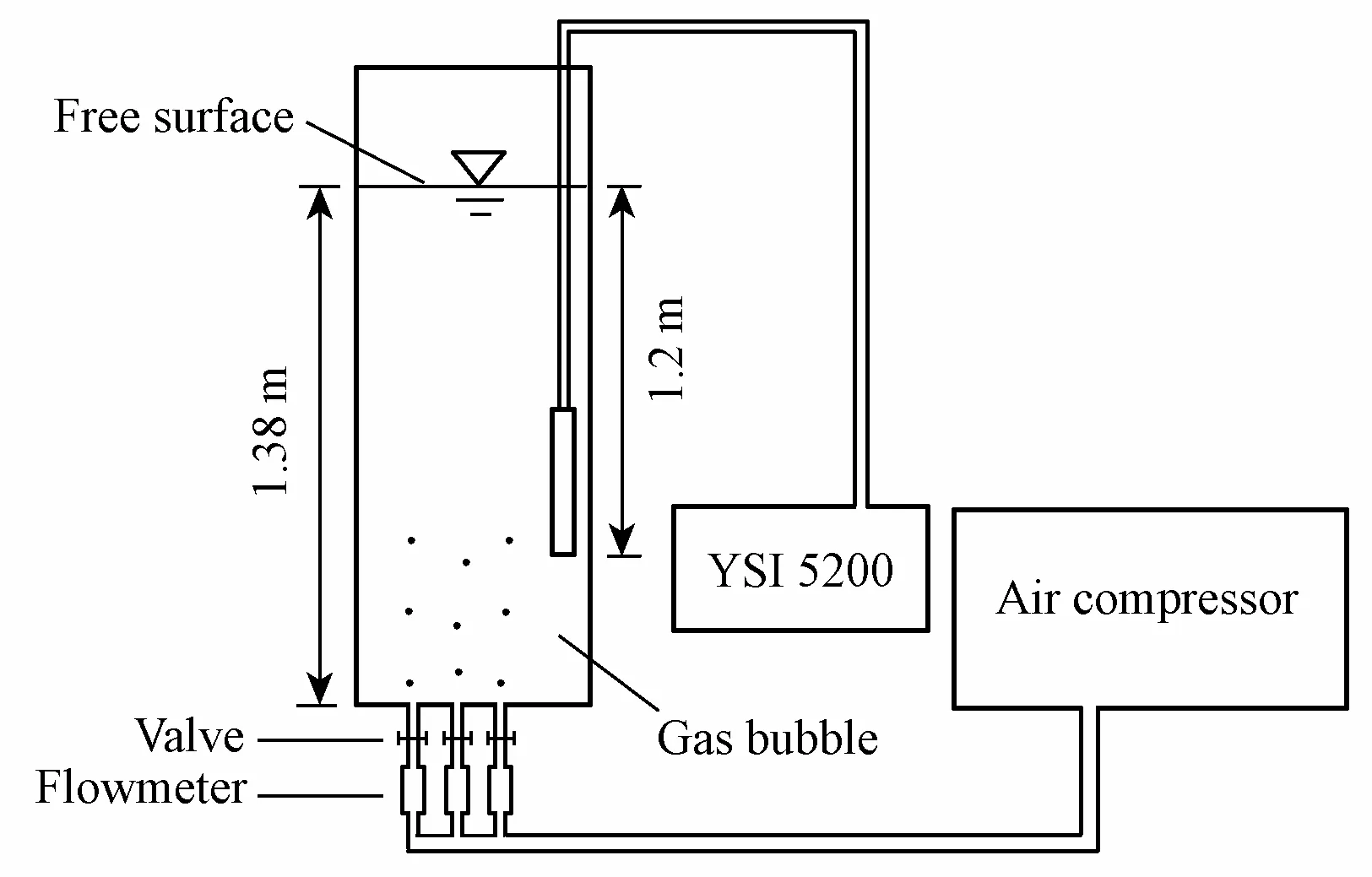
Fig. 1 Sketch of experimental device of gas bubble dissolution
Experiments were carried out under two conditions. Under condition 1, gas was mixed with water through a single pinhole at a flow rate of 0.20 L/h. Under condition 2, gas was mixed with water through three pinholes at a flow rate of 0.61 L/h. The change process of TDG saturation level is shown in Table 1.

Table 1 Change of TDG saturation level in gas bubble dissolution experiment
These results show that for the single-pinhole aeration (condition 1), the aeration intensity is low, and the gas can not quickly dissolve in the water because the air-water contact area isextremely small and turbulence is weak. For the three-pinhole aeration (condition 2), the collision between bubbles is more intense, and the gas dissolves more quickly because the air-water contact area is larger. The TDG level reaches 100% of saturation in a relatively short period of time. These experiments demonstrate that the gas dissolution rate is associated with the air-water contact area and turbulence intensity.
3.2 Impact of gas bubble size
In order to further verify that the gas bubble size plays a role in TDG supersaturation, we designed an experimental apparatus for studying the impact of the gas bubble size (Fig. 2). The main device included a 2.0 m-high, 0.4 m-diameter outer plexiglass cylinder, a 0.5 m-high, 0.2 m-diameter inner plexiglass cylinder fixed on the inside of the outer plexiglass cylinder, and two cylindrical metal sieves with apertures of 150 um. The lower sieve (sieve 1) was fixed on the upper surface of the inner cylinder, and the upper sieve (sieve 2) was mounted on a rotating shaft. The two sieves were close to each other but were not in contact with each other. An air compressor was linked to the bottom of the inner cylinder. The experimental water depth was 1.8 m. The probe was placed at a depth of 1.1 m underwater.
The experimental gas was provided by the air compressor at a working pressure of 3 atm. Gas generated by the air compressor formed bubbles after passing through the lower sieve on the inner cylinder. Then, the bubbles overflowed outwardly, and were changed into tiny air bubbles when they encountered the high-speed rotary shear of the upper sieve. In order to study the effects of bubble shear on the TDG saturation level, we also conducted a test in which the upper rotating sieve (sieve 2) was not installed (Fig. 3).
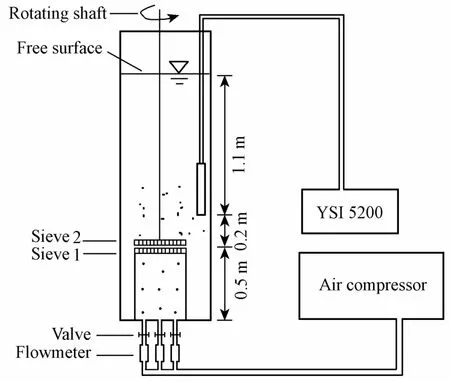
Fig. 2 Sketch of experimental device for studying impact of gas bubble size
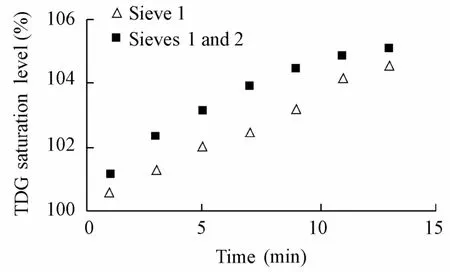
Fig. 3 Changes of TDG saturation level through experiment for studying impact of gas bubble size
The results of these two group experiments show that when there is no sieve 2, the gas bubble diameter is larger, turbulence is weaker, and the generation rate of TDG supersaturation is lower. This indicates that the gas bubbles of smaller size dissolve more quickly because the air-water contact area is larger.
3.3 TDG release experiment
The experimental device for TDG release is shown in Fig. 4. In order to maintain a constant depth in the water container, an overflow port was set at a depth of 1.08 m. A pump was used to maintain the circulation of water. Near the mouth of the pipe, there was a T-junction that enabled a high-velocity flow to carry the gas. A free-jet flow formed at 0.50 m over the water surface. The velocity of the jet flow was about 70 m/s.
The change of TDG saturation level is shown in Fig. 5. The results show that the TDG saturation level decreases continuously. The reason is that the locally negative pressure generated by the structural style of the T-junction leads to the release of TDG in the circular flow. This indicates that a certain pressure is required to maintain the TDG saturation level.

Fig. 4 Sketch of experimental device for TDG release

Fig. 5 Change of TDG saturation level in TDG release experiment
4 Study of generation of supersaturated TDG
4.1 High-speed air-water jet flow experiment
The experimental gas was provided by an air compressor at a working pressure of 3 atm. A jet flow formed in the water container on the right side after the airflow generated by the air compressor and the water flow generated by the pump were mixed. The experiments were carried out under two conditions: the water surface free jet and underwater submerged jet. The distance between the free jet point and the water surface was 0.5 m. The submerged jet point was located 0.5 m below the water surface.
Fig. 7 shows the changes of the TDG saturation level with time. The TDG saturation level in the free jet flow was lower. The gas in the free jet flow lacked sufficient power to enter the water, so it was unable to form high-degree supersaturated water. For the submerged jet, the gas in the jet flow had full access to water and therefore dissolved rapidly. The TDG saturation level in the water was dependent on the water depth (pressure). The experimental resultsindicate that sufficient aeration and pressure (depth) are required for supersaturated TDG generation. At the same time, the retention time of bubbles in the water is a main factor that influences the supersaturated TDG generation.

Fig. 6 Sketch of experimental device for high-speed air-water jet flow

Fig. 7 Changes of TDG saturation level in high-speed air-water jet flow experiment
4.2 High-speed aerated flow experiment
A high-speed aerated flow experiment was designed to test the effect of the high-speed aerated flow on supersaturated TDG generation. The experimental apparatus is shown in Fig. 8. The height, diameter, and depth of the experimental water container were 6.0 m, 0.2 m, and 4.0 m, respectively. A high-speed circulating jet flow was generated by a pump. The jet exit was located at a depth of 3.0 m underwater, and the jet velocity was 70 m/s. The experimental gas was provided by an air compressor at a working pressure of 3 atm. The outlet of the gas flow was close to the outlet of the high-speed jet flow. The TDG test point was located at a depth of 2.5 m underwater.
The experiment was conducted under three different conditions. Under condition 1, there was high-speed circulating water flow and no air compressor aeration. Under condition 2, there was air compressor aeration and no high-speed circulating water flow. Under condition 3, there were simultaneous high-speed circulating water flow and air compressor aeration. The changes of the TDG saturation level in the experiments are shown in Fig. 9.

Fig. 8 Sketch of experimental device for high-speed aerated flow
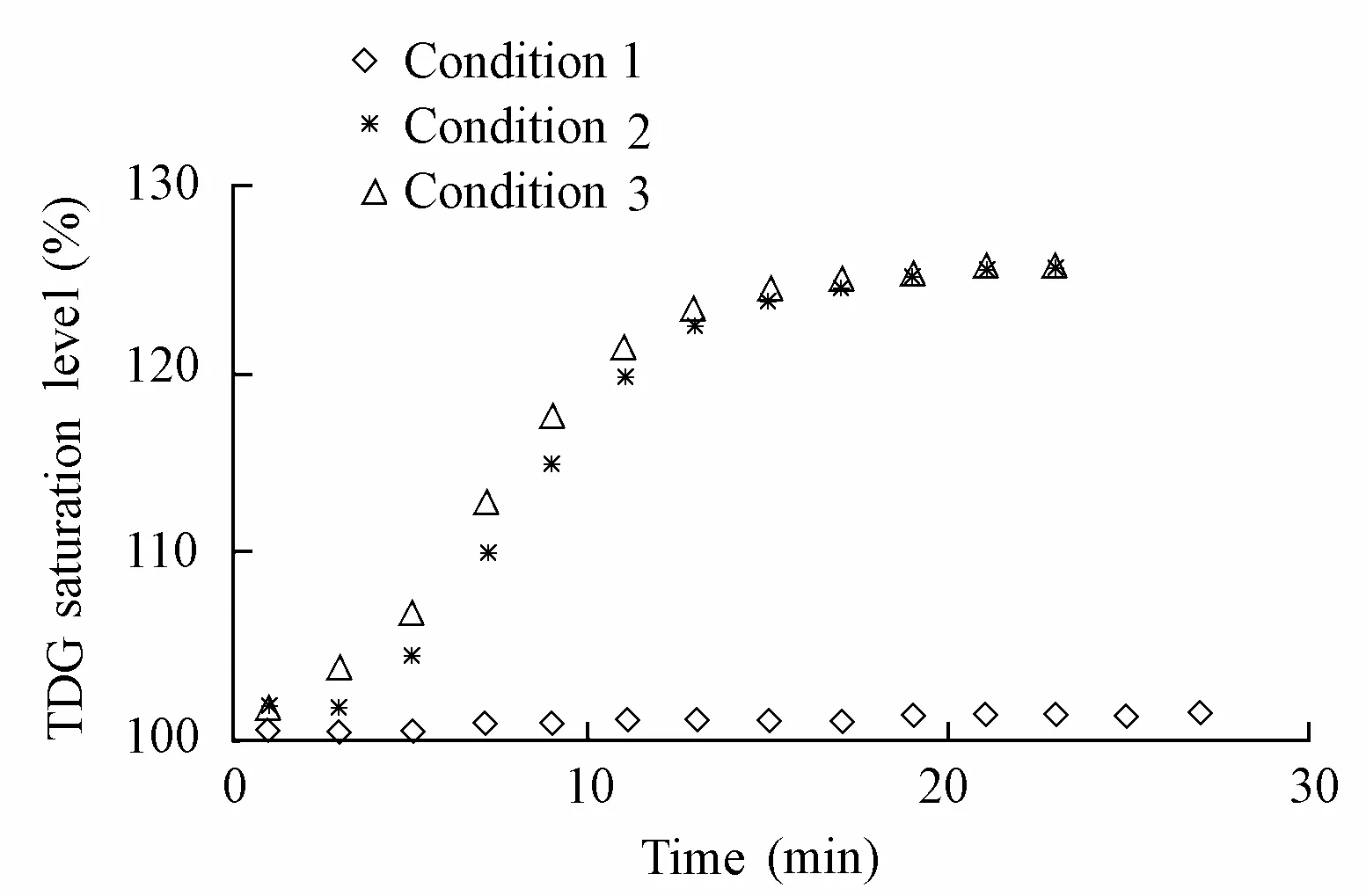
Fig. 9 Changes of TDG saturation level in high-speed aerated flow experiment
Under condition 1, despite of the strong turbulence caused by the high-speed water flow, the TDG saturation level at the test point was only 101.7%. This was possible due to the fact that water was mixed with a small amount of air on the free surface, and there was only a small amount of gas dissolved in the water. The experimental results indicate that aeration is a necessary component for the supersaturated TDG generation. Under condition 2, bubbles collided with each other because of a large amount of aeration. Thus, the air-water contact area became larger. At the same time, the hydrostatic pressure and turbulence caused the bubbles to dissolve faster. The TDG saturation level rapidly came to the maximum TDG saturation level, 125.4%. Under condition 3, because the high-speed water flow cut the aerated bubbles, the bubble sizes were smaller than those under condition 2, the air-water contact area increased, and the bubbles dissolved even faster. The TDG saturation level reached 125.4% more rapidly than under condition 2. The experimental results from conditions 2 and 3 indicate that the air-water contact area (bubble size) and turbulence intensity are the main factors affecting the generation rate of TDG supersaturation.
The degree of TDG supersaturation for the experimental circulating water had no effect on the maximum degree of TDG supersaturation that the water ultimately achieved. Therefore, we conclude that the TDG saturation level in the stilling basin has no direct relationship with that in the reservoir.
In the case of the circulating jet, the TDG saturation level in the water gradually increases beyond the initial TDG saturation level. When the TDG saturation level reaches the maximum saturation level, it will not further increase in the continuous aeration. For any TDG saturation level upriver, when the dam discharges water, the maximum TDG saturation level of downstream flood water is not affected.
评级体系作为公共图书馆必不可少的一部分,在LibQUAL+TM、HAPLR和LJ3种评价体系中,LibQUAL+TM是对图书馆自身的情况进行评价,HAPLR和LJ是对多个同类图书馆评价并排列,但两者的分类标准并不一致。LibQUAL+TM通过用户利用图书馆后的切身感受进行评价,HAPLR和LJ通过图书馆向IMLS提供客观数据进行严格计算,以评分排列。3种评价体系都各有所长,LibQUAL+TM可以清楚了解图书馆的不足之处,HAPLR分组合理,计算方法简单,LJ指标简单精炼,涵盖性高。我国公共图书馆仍有发展的空间,充分利用评价体系可更大程度地提高公共图书馆信息服务质量。
5 Conclusions
In this study, the generation conditions of TDG supersaturation downstream of dams were examined through a series of experiments. The results indicate that pressure (water depth), aeration intensity, and bubble dissolution time are important factors that influence the generation of supersaturated TDG. The turbulence intensity and water-air contact area (bubble size) are the main factors that affect the generation rate of supersatured TDG. The smaller the gas bubble diameter is, the more quickly it dissolves because of the larger air-water contact area, and the faster the generation rate of supersatured TDG is. The stronger the turbulence is, the higher the generation rate of supersaturated TDG is. This indicates that sufficient aeration and pressure (water depth) are required for supersaturated TDG generation when the high dam discharges water. Larger water depth and higher pressure can generate a higher TDG supersaturation level. The circulated jet experiment designed in this study can not effectively raise the maximum TDG supersaturation level. This indicates that, during the spill period of the dam, the TDG saturation level in the stilling basin has no direct relationship with that in thereservoir. As the maximum TDG supersaturation level is closely related with pressure, the TDG supersaturation can be reduced by reducing the water pressure. The supersaturated TDG level can be reduced by discharging water to shallow shoals downstream of the dam or using negative pressure pipelines in practical engineering.
The results are of great importance for further research on the prediction of supersatured TDG generation and aquatic protection. The factors influencing supersatured TDG generation are very complicated because the air-water two-phase flow affects the supersatured TDG generation when the high dam discharges water. In addition, the conditions for the supersatured TDG generation in the experiments and prototypes were not all the same. The physical conditions of the TDG dissolved in water were analyzed through the experiments. The results of qualitative analysis are reliable, but for quantitative study, these experimental conditions are not sufficient. In the future study, we need to consider how to build a hydraulic model of supersaturated TDG. The effects of the energy dissipation pattern, spill rates, and operation modes need to be considered in the model when the dam discharges water. This suggests that the experimental apparatus need to be further improved. Furthermore, the theory and numerical simulation of supersatured TDG generation are important issues that require further research and discussion.
Chen, Y. B., Peng, Q. D., and Liao, W. G. 2009a. The evolvement study on supersaturation of dissolved gas in the middle reaches of Yangtze River after the Three Gorges Project running.Journal of Hydroecology, 2(5), 1-5. (in Chinese)
Chen, Y. C., Fu, J., Liu, Z. W., Cheng, X. J., and Zhu, D. J. 2009b. Analysis of the variety and impact factors of dissolved oxygen downstream of Three Gorges Dam after the impoundment.Advances in Water Science, 20(4), 526-530. (in Chinese)
Feng, J. J., Li, R., Li, K. F., Li, J., and Qu, L. 2010. Study on release process of supersaturated total dissovled gas downstream of high dam.Journal of Hydroelectric Engineering, 29(1), 7-12. (in Chinese)
Huang, H. Q. 2002.Computational Model of Total Dissolved Gas Downstream of a Spillway. Ph. D. Dissertation. Iowa: University of Iowa.
Jiang, L., Li, J., Li, R., and Li, K. F. 2008a. A study of dissolved gas supersaturation downstream of Zipingpu dam.Advances in Water Science, 19(3), 367-371. (in Chinese)
Jiang, L., Li, J., Li, R., and Li, K. F. 2008b. The supersaturation of dissolved gas in downstream of high dam.Journal of Sichuan University (Engineering Science Edition), 40(5), 69-73. (in Chinese)
Li, R., Li, J., Li, K. F., Deng, Y., and Feng, J. J. 2009. Prediction for supersaturated total dissolved gas in high-dam hydropower projects.Science in China, Series E: Technological Sciences, 52(12), 3661-3667. [doi:10.1007/s11431-009-0337-4]
Orlins, J. J., and Gulliver, J. S. 2000. Dissolved gas supersaturation downstream of a spillway : ⅡComputational model.Journal of Hydraulic Research, 38(2), 151-159.
Politano, M., Carrica, P., Turan, C., and Weber, L. 2007. A multidimensional two-phase flow model for the total dissolved gas downstream of spillways.Journal of Hydraulic Research, 45(2), 165-177. [doi:10.1080/00221686.2007.9521757]
Politano, M., Carrica, P., and Weber, L. 2009. A multiphase model for the hydrodynamics and total dissolved gas in tailraces.International Journal of Multiphase Flow, 35(11), 1036-1050.
Qin, C. L., and Li, L. 2008. Numerical model of dissolved gas supersaturation flow over spillway of GezhouDam Project.Science and Technology Review, 26(18), 45-48. (in Chinese)
Qu, L., Li, R., Li, J., Li, K. F., and Deng, Y. 2011. Field observation of total dissolved gas supersaturation of high-dams.Science in China, Series E: Technological Sciences, 54(1), 156-162. [doi:10.1007/ s11431-010-4217-8.]
Tan, D. C. 2006.Research on the Lethal Effect of the Dissolved Gas Supersaturation Resulted from Three Gorges Project to Fish. Chongqing: Southwest University. (in Chinese)
Tan, D. C., Ni, Z. H., Zheng, Y. H., Li, L. Y., and Li, Y. F. 2006. Dissolved gas supersaturation downstream of dam and its effects on fish.Freshwater Fisheries, 36(3), 56-59. (in Chinese)
Urban, A. L., Gulliver, J. S., and Johnson, D. W. 2008. Modeling total dissolved gas concentration downstream of spillways.Journal of Hydraulic Engineering, 134(5), 550-561. [doi:10.1061/(ASCE) 0733-9429(2008)134:5(550)]
U.S. Army Corps of Engineers (USACE). 2005.Technical Analysis of TDG Processes. Jacksonville: U.S. Army Corps of Engineers-Northwest Division, Environmental Resources and Fish Planning Offices.
Watson, C. C., Walters, R. W., and Hogan, S. A. 1998. Aeration performance of low drop weirs.Journal of Hydraulic Engineering, 124(1), 65-71. [doi:10.1061/(ASCE)0733-9429(1998)124:1(65)]
Weitkamp, D. E., and Katz, M. 1980. A review of dissolved gas supersaturation literature.Transactions of the American Fisheries Society, 109(6), 659-702. [doi:10.1577/1548-8659(1980)109<659:ARODGS> 2.0.CO;2]
This work was supported by the National Natural Science Foundation of China (Grant No. 50979063).
*Corresponding author (e-mail:liran@scu.edu.cn)
Received May 1, 2011; accepted Oct. 8, 2011
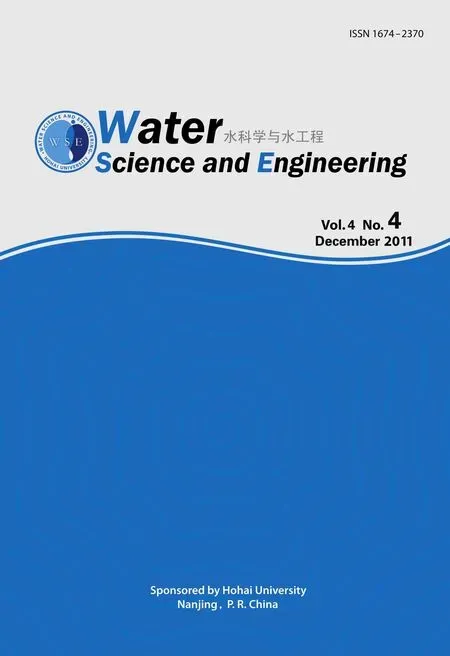 Water Science and Engineering2011年4期
Water Science and Engineering2011年4期
- Water Science and Engineering的其它文章
- Two-dimensional physical habitat modeling of effects of habitat structures on urban stream restoration
- Hydrodynamic effects of reconnecting lake group with Yangtze River in China
- Sediment transport following water transfer from Yangtze River to Taihu Basin
- Research on shape optimization of CSG dams
- Analysis of black water aggregation in Taihu Lake
- Large eddy simulation of water flow over series of dunes
